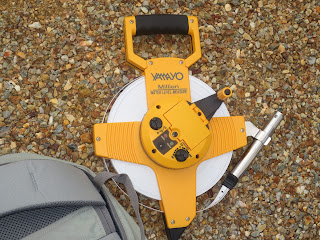Well is simply a shaft sunk into the ground or built upwards from
certain depths below a natural surface of the ground which extends further
above certain heights of the natural surface of the ground
Wells can be naturally
occurring or man-made. Man-made wells are created to suite the desired
purpose(s) of the organisation or individuals. Wells can be created to collect water
or oil or gas below the earth’s surface.
In a mining operation, wells are created for the purposes of heap
leaching through a vat. Heap Leaching is one of the various mining techniques
to extract gold from the ore of various host rocks using cyanide which is one
of the common solvent in this gold recovery technique.
During the gold recovery process, cyanide is sprinkled over the
heap of crushed gold bearing gravels (ore) to dissolve the gold into a pregnant
solution or into liquid form. The pregnant solution is then sucked out through
the vat and further into carbon columns and take to the processing plant for
further processing and smelting.
Upon the closure of the mine, the vats are no longer in use. Cyanide
is left behind the pool beside the heap-vats eventually gets into the surrounding
environment which is a concern for mine waste management. Water is then filled
through the Vats up to certain heights. So
from the top and surface of the heap-vats, the water level is below certain depths
of about 2 – 3 meters which are hardly reached by hand. And also the diameter
of the vats is about 30-40 cm which is too narrow to be accessed. So how can
you how can you overcome this challenge to take a water sample for a Rapid PACKTEST
as well as other measurements?
The simple way to get sample is by utilizing the following
equipment procedures:
1. String line (rope)
2. Metal weight(1kg weight)
3. 3x1 Litre plastic bottle(container)
4. Masking tape
5. Water level measuring tape
6. GPS
7. Note book, pen, pencil
8. Camera
9. Blade/kitchen knife
11. Syringe
12. 0.45µm
filter
13. turbidity
meter
14. pH meter
15. Laptop/computer
Procedure
1. Cut the 1 Litre plastic bottles (container)
into more than half.
2. Tie the 1kg metal weight at the tip of the
string line.
3. With the masking tape, fasten the cut container
with the weight attached to the string line.
4. Drop the container attached to the weight
and stringline into the well and allow the container to be filled with water.
5. Pull the string line with all its attached
items and pour the fetched water into the other reserved containers.
6. Never forget to measure the water level by
using the 50m water level measuring tape.
7. Using the GPS you take the readings of
sample location coordinates and altitude and location zone.
8. Finally , you conduct Rapid PACKTEST and
9. Turbidity and pH measurements,
conductivity and temperature readings as well.
The above procedure can be repeated for wells or pools that are
hardly accessible in person or by hand.
Data Collection of the Rapid PACKTEST is the final thing to do before moving to the
next location or ending the field work.















0 comments:
Post a Comment